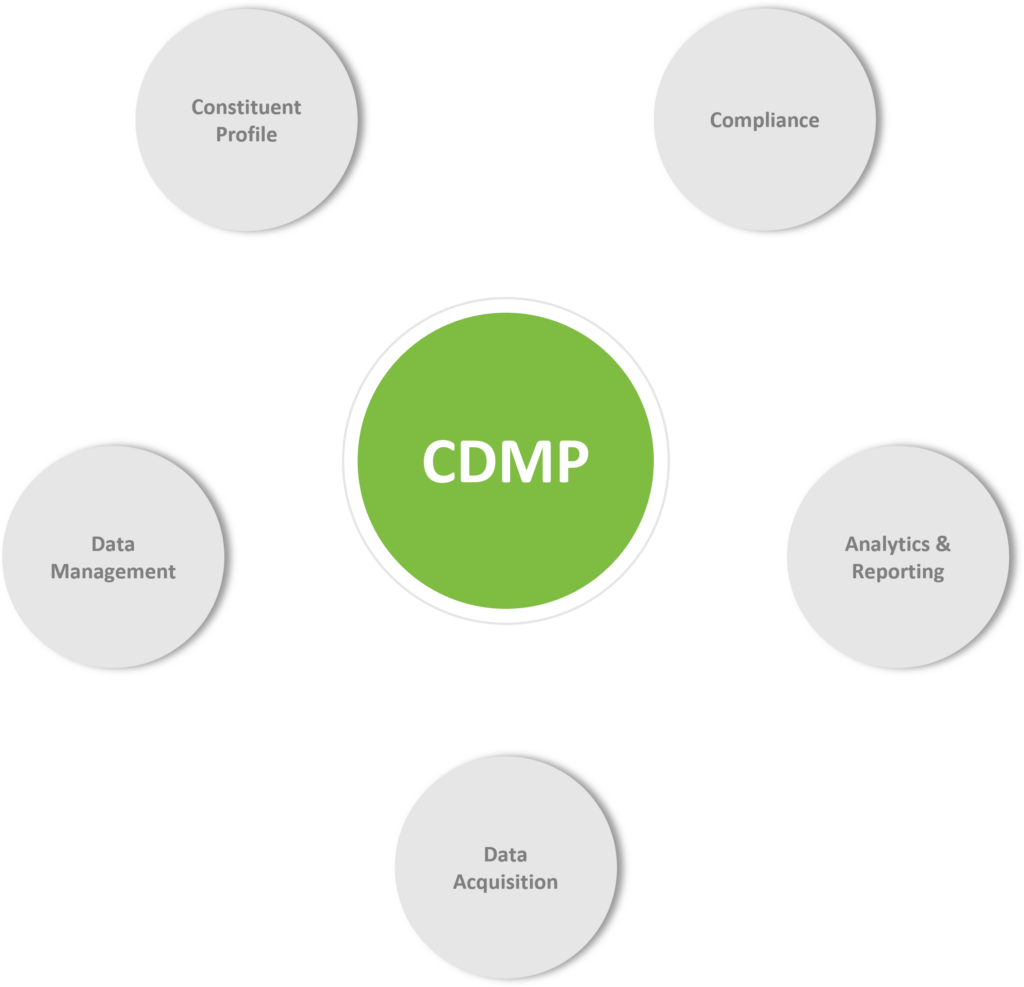Constituent Data Management Platform
What is a Constituent Data Management Platform?
Like a Customer Data Platform (CDP) and Data Management Platform (DMP), a Constituent Data Management Platform (CDMP) combines the best of both technologies into a single platform developed exclusively for the non-profit industry.

The following sections describe each functional component of the CDMP and the features. These are listed according the placement in the diagram, and not by process stage or RELATIVE PRIORITY OR importance.
– Constituent Profile
The constituent profile is the single most important part of the CDMP. It determines which entities and attributes are managed for each constituent record.
Having a comprehensive profile allows organizations to better understand their constituent population, provide better personalization of content, and communicate more effectively.
The following list represents a sample of the entities we have built into the standard data model.
- Demographics & Firmograpics
- Assets
- Interests
- Activities
- Relationships
- Transactions
– Data Management
Data management is what we do best. From data hygiene to data deduplication, we have this covered. Since data exists is always in more than one place, we have the ability to perform batch, manual, and automated integration processing to bring all data together in one consolidated environment.
The following list represents a sample of the data management processes we have built into the platform.
- CASS/DPV/NCOA
- Proprietary change of address
- Deceased suppression
- Data enhancement, including: email addresses, postal addresses, and phone numbers
- Data duplication
- Data reconciliation and quality control
– Data Acquisition
Data acquisition is the process of getting real-time data into the system. Through data management, most static data makes it’s way into the CDMP, but this may not include the real-time data you need to help support data-driven processes.
Through our powerful REST and JS APIs (Application Programming Interfaces), data from any number of external systems can submit data and have it processed through the same robust data management functions as all other data.
The following list represents a sample of the data acquisition sources and processes we have built into the platform.
- Website visitors
- Event registrations
- Social media
- News feeds
- Investment information
- Compliance feeds
– Analytics & Reporting
One of the more critical components of the platform is analytics and reporting. The platform goes way beyond traditional analytics & reporting by integrating PowerBI and AutoML. This allows organizations to perform predictions in real time, and to enable fundraisers and other frontline personnel to act quickly to changes in the constituent ecosystem.
The following list represents a sample of the analytics & reporting features we have built into the platform.
- Geocoding and mapping
- Dynamic pivot tables and graphs
- User-defined subscriptions and notification
- Automated machine learning
- Custom scoring and weighting algorithms
- Quality assurance reporting
– Compliance
With the compliance landscape continuously changing, it is critical to know that your platform has the ability to manage these without requiring additional setup and configuration, as well as to be flexible enough to rapidly implement new compliances and required changes to support modifications to existing compliances.
The following list represents a sample of the compliance features we have built into the platform.
- Attribute-based targeting, like geography
- Well-known compliances, like GLBA, FCRA, HIPAA, etc.
- Compliance-based due diligence
- Legal document tracking
- Chain of custody tracking
- Security-based compliances, like SOC, PCI, etc.